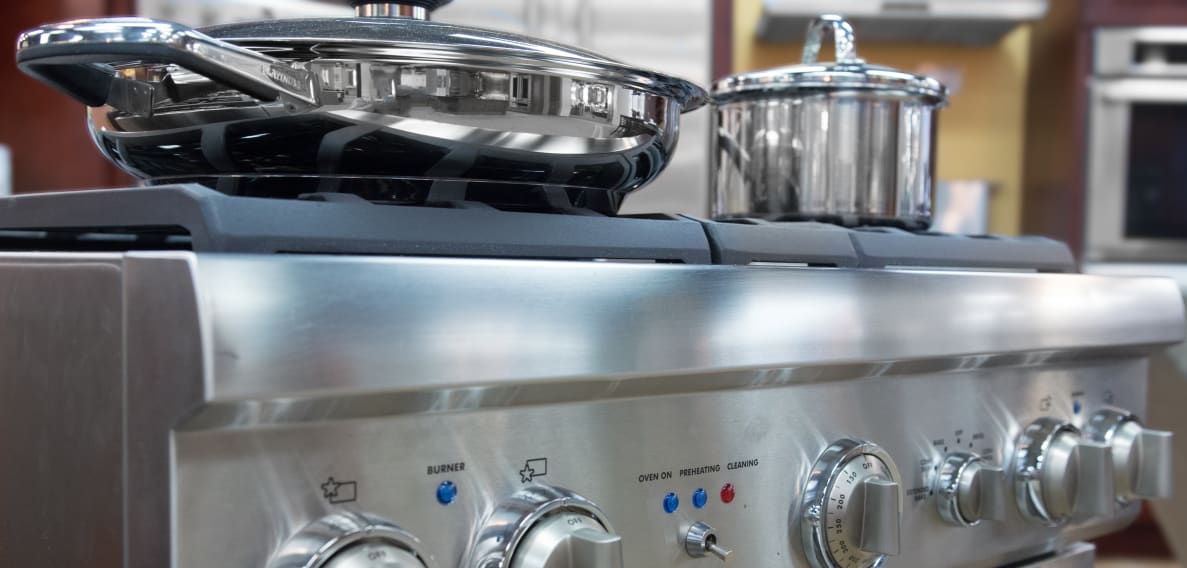In our tests, it paired impressive cooking abilities and ease of use with the appearance and build quality of an upscale, pro-style appliance
Sleek stainless steel, continuous cast iron grates, and simple knob controls give this 30-inch range a look that's straight out of a restaurant kitchen, but don’t think you have to have a Michelin star to use it—the rangetop and oven are intuitive to operate, and there’s no denying how effectively they can cook.
The stars of the show are—literally—the PRD304GHU’s star-shaped pedestal burners, two of which are equipped with an ExtraLow simmer system that puts rangetop temperatures as remarkably low as 86°F within reach. The 4.4 cubic-foot oven handled baking like, well, a pro, during our extensive scientific testing. Plus, it offers just enough special features to help you out without getting in the way.
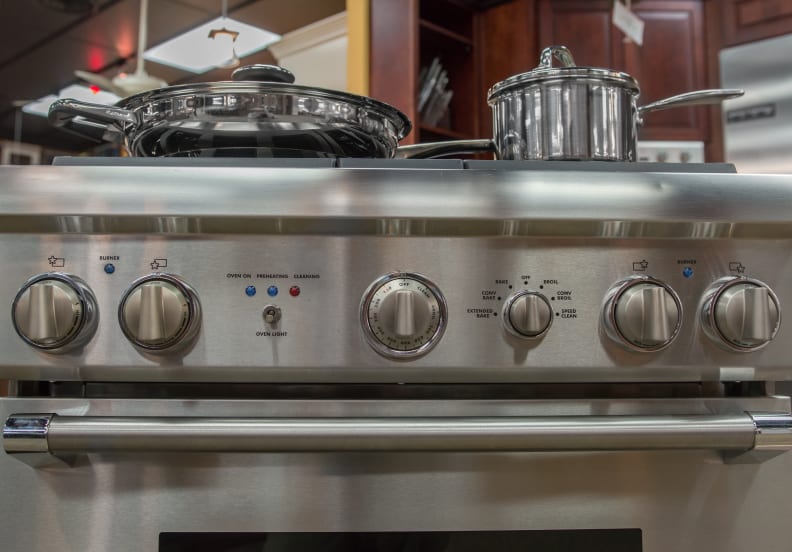
A professional-style handle and control knobs mean this range would look at home in a restaurant kitchen.
Overall, though, simplicity seems to be the name of the game with this clean, functional range—all the better to let its stellar cooking abilities shine through.
Design
Pared-down and professional
The PRD304GHU is part of the Thermador Pro Harmony series. That means it's a 24-inch deep range, and designed to fit flush with cabinetry. The Pro Grand series is 27 inches deep and only comes in 36-inch widths and wider. However, it also features one more powerful burner.
{{ photo_gallery name="Design Gallery" }}
When you interact with the 30-inch-wide, 24-inch-deep PRD304GHU, you'll immediately notice just how well it's put together. Apart from the heavy, easy-to-remove cast iron grates, the range is covered in thick, smooth stainless steel. A professional-style stainless steel handle juts from the oven door, while solid metal rangetop and oven control knobs pepper the control panel above. The surface below the burners is coated in porcelain for easy cleaning, and the oven has a two-hour self-clean cycle.
The range comes with a toekick, which can be installed for a built-in look. A backguard is sold separately. Indicator lights are blue and quite bright—and add some color to the range when it's in use. As with many other pro-style ranges, the PRD304GHU does not come with a clock or timer, which preserves its restaurant kitchen look.
{{ photo_gallery name="Brand-supplied" }}
Made up of sharp lines, cleanly welded corners, and all that stainless steel, the PRD304GHU should fit beautifully in most kitchens—so long as you like that high-end commercial style.
Customizability
Backguards, control knobs, and rangetop accessories
If you’re looking to add a backguard to your range, Thermador has two options for the PRD304GHU. A 9-inch low backguard (Model PA30GLBH—MSRP $399) will protect the wall directly above the range, while a 22-inch high shelf backguard (Model PA30GHSH—MSRP $599) offers further wall protection, plus an additional shelf for storage. Both backguards are made of stainless steel.
Hoping for greater rangetop versatility? You can nab a Thermador Professional Wok Ring Accessory (MSRP $99) or two, or a Professional Griddle Accessory (MSRP $139) to sit atop your existing burners.
If the traditional weighted metal control knobs aren’t doing it for you, Thermador offers a Blue Metal Knob Kit (Model PAKNOBLU—MSRP $199) to give the option to increase the range’s visual interest. The PRD304GHU isn’t brimming with customization options, but if you find it worth the extra cost, there are certainly several ways to build upon the looks, convenience, and function of this range.
Rangetop
Star of the kitchen
The PRD304GHU’s rangetop sports four sealed 18,000 BTU star-shaped gas burners and a porcelain cooking surface. Three cast iron grates provide a continuous surface for your pots and pans, with enough space in the middle of the range to rest cookware when you take it off the heat.
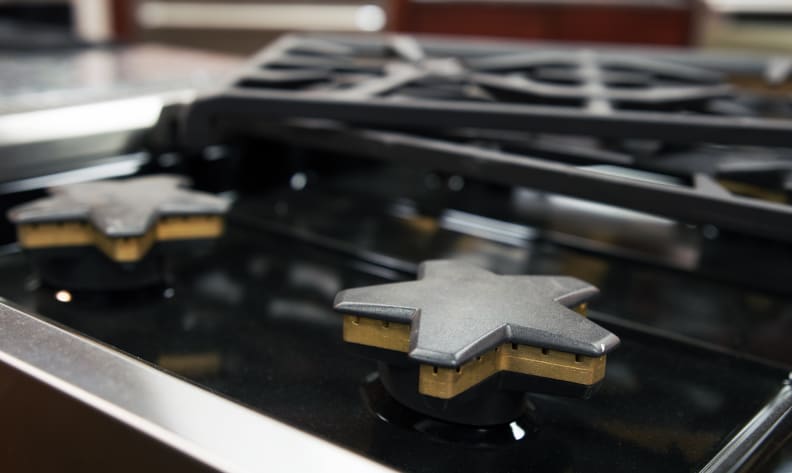
Grates can be removed to reveal star-shaped burners.
Burners are star-shaped, with tall bases designed to allow room for a sponge during rangetop cleaning. Thermador says the unique burner shape is designed for even heat distribution. We happen to think it's attractive—especially when rimmed with blue flame. The solid metal rangetop control knobs made a satisfying thunk when twisted between simmer, medium, and high settings (and, in the case of both left-hand burners, ExtraLow.)
All of the four 12-inch burners are powerful, but the burners on the left side of the rangetop are especially unique, boasting Thermador’s impressive ExtraLow simmer system. This means that the burners—capable of outputting as little as 375 BTU—will cycle on and off in order to maintain startlingly low temperatures. During testing, those lefthand burners lived up to the hype, with the left rear burner dropping down to a balmy 86°F and the left front burner bottoming out at 90°F. Just be aware that there will be a clicking noise as the burners cycle on and off!
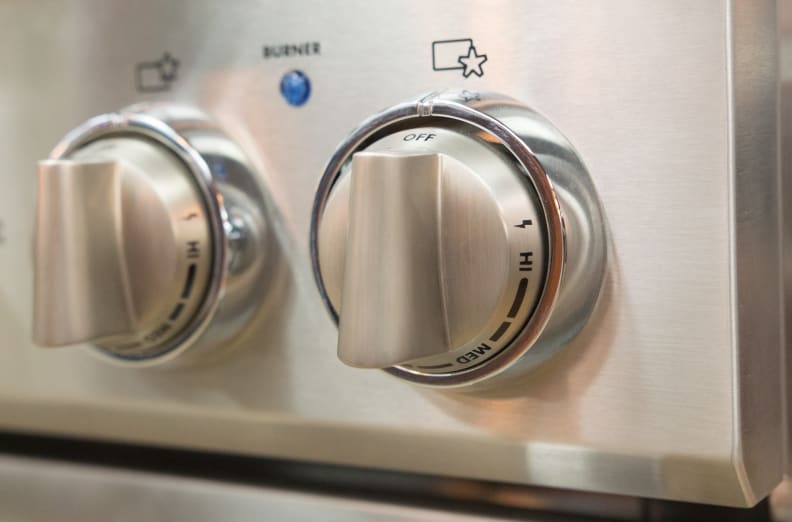
Rangetop control knobs sit at the front of the range.
Burners on the right side of the range can’t hit simmer temperatures anywhere near as low without the ExtraLow simmer option, but still can get to an acceptable 150°F. That makes Thermador's burners the most versatile we've ever tested.
Maximum temperatures fell in a much smaller range. Gas rangetops don’t get as hot as electric or induction, but the PRD304GHU should heat up enough to allow for a sizzling stir fry or crispy-skinned salmon fillet. None of the burners cracked 400ºF, but got pretty close—386ºF, to be exact.
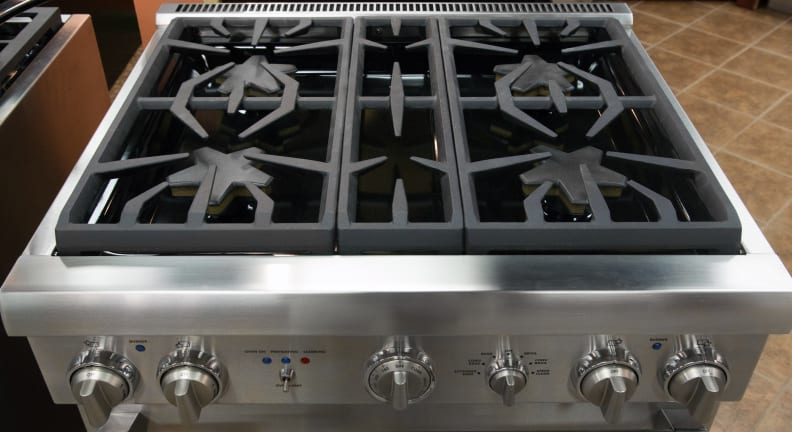
Star-shaped burners are able to hit especially low temperatures on the left side of the range.
The rangetop is quick to boil water overall, but the front burners are definitely faster, with the left front boiling 6 cups in just over 5 minutes, and the right front in just under 6. That's very impressive.
The PRD304GHU's layout makes it a joy to cook on. None of the burners are duds, so you've got a ton of versatility. Simmer or melt on the left side of the range, boil on the front, and do high-heat cooking just about anywhere—it won’t make much of a difference.
Oven
Convection gives this oven an edge
The 4.4 cubic-foot electric oven houses two standard racks and one telescopic rack that can be swapped between six different height placements, plus 8-pass bake and broil elements. At the rear of the oven, a convection fan and third heating element hold the promise of true convection.
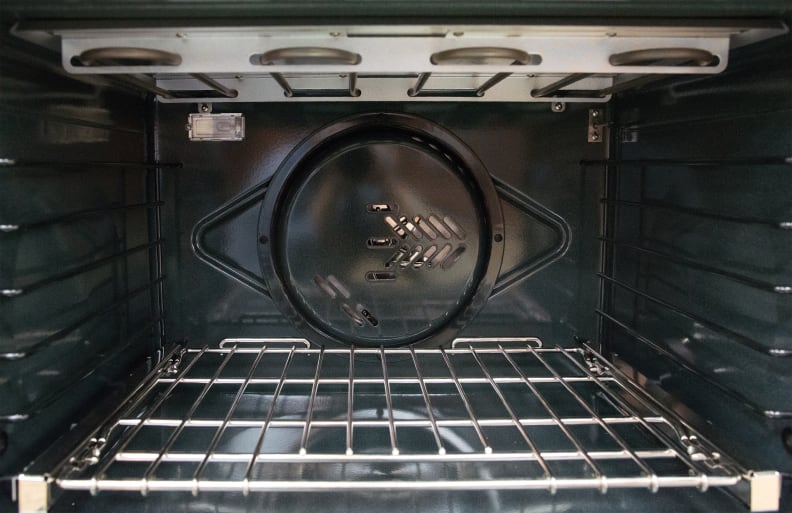
The convection setting allowed for even baking and roasting.
Oven controls are two knobs located on the front center of the range. Select temperature with the left-hand dial, and choose between Bake, Extended Bake, Convection Bake, Broil, Convection Broil, and Speed Clean with the right. Slightly counterintuitive: To broil, you’ll have to select the Broil setting on both dials, and running the self-clean cycle requires selecting Clean on the left and Speed Clean on the right. Three small lights to the left of the oven controls indicate whether the oven is turned on, preheating, or self cleaning, and a switch illuminates the cavity’s halogen lighting.
Again, the controls are fairly simple to look at, but the oven truly shines when it comes to baking. The cavity preheated to 350°F in just over 11 minutes at a standard setting, but took just under 8 with convection. If you’re looking to broil, you won’t have to wait long for the area beneath the broiler to reach a scorching 610°F—in fact you’ll only have to wait about 6 minutes.
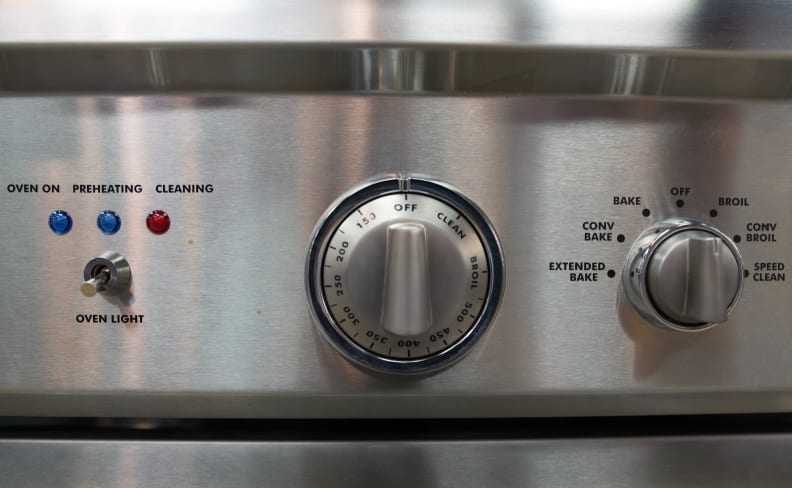
When we baked cakes and cookies in the oven, we used a photospectrometer (a device that determines differences in color) to measure exactly how evenly-browned the results were. Cookies were evenly-browned at both standard and convection settings. Cookies had darker bottoms than tops and varied slightly in doneness throughout the oven cavity when we used the standard bake setting, but convection fixed this problem. At the end of the day, the convection setting made all our baked goods better.
Roasting was less of an obvious success, but by no means a failure: A pork loin we roasted in the oven with the standard bake setting still proved outstandingly juicy, cooking through to 160°F in just 36 minutes. The main issue with the roast was uneven browning. Use of the Convection Bake setting improved the roast just a bit, yielding a slightly drier but slightly more evenly browned pork loin in just over 33 minutes. The difference is almost negligible, but you might as well use convection for roasting meat, as it did result in a more well-rounded roast.
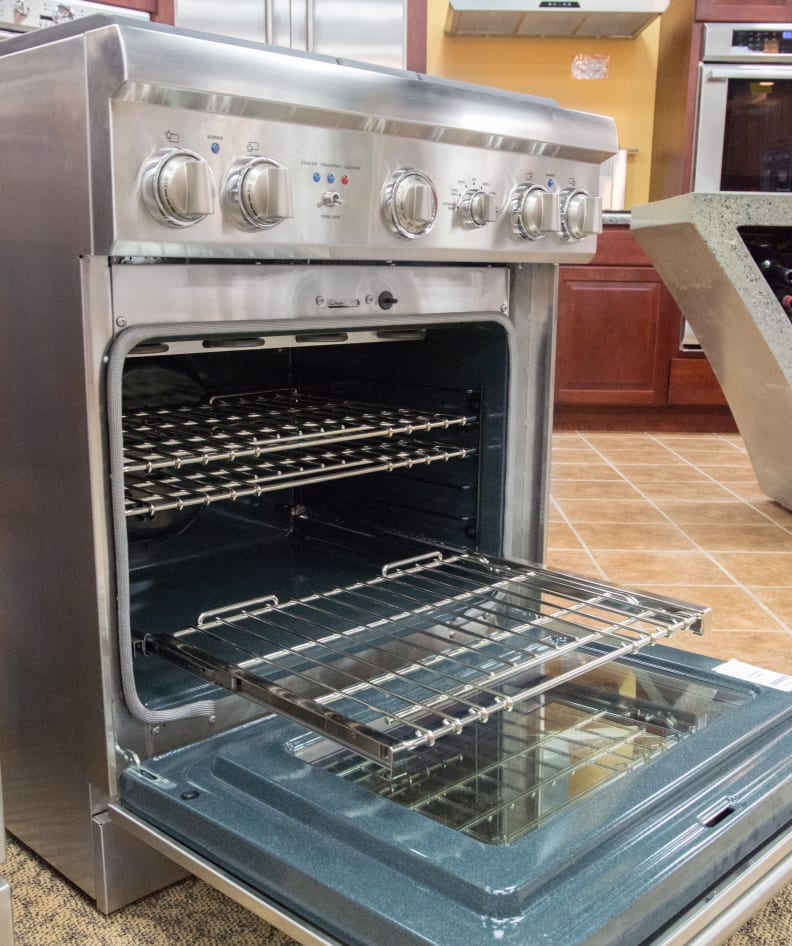
The oven is well-equipped for baking and roasting.
The PRD304GHU’s oven is what we hope for in pro-style ranges: At a glance, it’s an ordinary oven with dial controls, but it has enough settings to satisfy those who want more than the bare minimum. Home cooks seeking a more pared-down experience won't find the extra settings intrusive, and it’s definitely a nice plus to see a self clean cycle on a high-end pro-style range. However, the main purpose of an oven is to bake food, and the PRD304GHU is well-equipped to do so. That’s the kind of quality performance that can make a high-end range worth the splurge.
Why We Like It
High-end, high-quality, high-performance.
When we test a high-end range, we expect to see quality materials, superior attention to detail, and smart design. The Thermador Pro Harmony PRD304GHU certainly doesn’t disappoint in that regard—but what elevates it above other upscale ranges is how well it can cook.
Neither loaded with extra features nor completely devoid, the PRD304GHU is a range you can expect to use daily. Its simplicity makes it easy to operate, and the solid control knobs feel pleasant to the touch. The rangetop is quick to boil, while the oven boasts a speedy preheat and roast time.
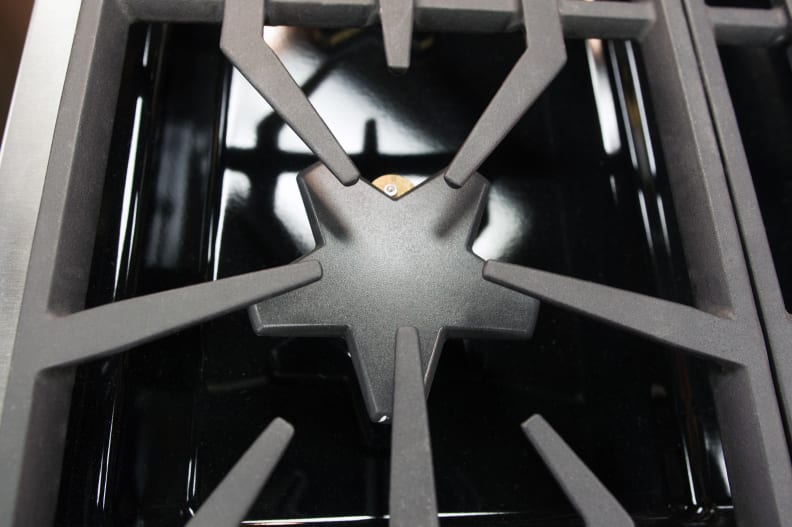
Gas burners are sealed and star-shaped.
Most importantly, the food we cooked on this Thermador earned our admiration for even browning and insignificant loss of moisture. It’s not perfect, but shortcomings are few and far between. There are other high-end ranges, like the GE Monogram ZDP364NDPSS, that offer a greater number of unique features, but the Thermador PRD304GHU is a great pick for those who want a range that maximizes what can be done in the kitchen.
Photos captured at Wickford Appliance & Lighting in Pawtucket, RI.
All-around great
We put the Thermador PRD304GHU through its paces during our scientific testing process, measuring its speed and cooking abilities and getting some hands-on experience using the range. While it didn’t blow us away in every testing category, the PRD304GHU received some of the best results we’ve seen from a high-end range of this sort, showcasing an excellent rangetop and effective oven.
Each of the rangetop’s four 12-inch burners provides up to 18,000 BTUs of cooking power, with both of the burners on the left able to provide as little as 375 BTUs using Thermador’s ExtraLow simmer system.
The left front burner had a maximum temperature of 364°F (the rangetop’s lowest max temp, but not by much) and a minimum temp as staggeringly low as 90°F. On High, it boiled water in just over 5 minutes. The left rear burner had a similar minimum temperature of 86°F, but was able to reach a slightly higher 379°F when it came to high heat. It did take longer to boil water, but its 6:27 boiling time was still fast enough.
Right burners were not able to get anywhere near the minimum temperatures we measured from the left burners. The right front burner could only dip down as far as 148°F, and had a reasonable maximum temperature of 375°F—plus it can boil six cups of water in 5:42. The right rear burner had the hottest temperatures for both minimum and maximum temperatures, but by a negligible amount. A 368°F topped off its temperature reach, while a 150°F low temp almost matched the right front burner’s minimum heat. Unfortunately, the right rear burner was also the slowest to boil, taking almost 9 minutes to boil six cups.
{{ photo_gallery name="Charts" }}
When it comes to oven testing, we make a point of seeing how well the oven can bake and roast real food. We baked two cakes side-by-side using standard and Convection Bake settings. Results were evenly-browned at both settings—and actually slightly better with the standard Bake setting. When we baked a sheet of cookies at both settings, the standard setting yielded abysmally uneven cookies, which varied in doneness across the cavity. However, the convection setting improved things a great deal. Because cakes were so successful at both convection and regular settings, we’d recommend using convection most of the time you bake, just to be on the safe side.
Roasting was not quite as successful, but still scored above the average. We cooked a pork loin in both regular Bake and Convection Bake, and found that while convection did improve the final product, there wasn’t a massive difference. Pork loin roasted with the standard bake setting was impressively moist, losing only 0.7 lbs of water during the fairly brief 36 min/lb it took to cook through to 160°F.
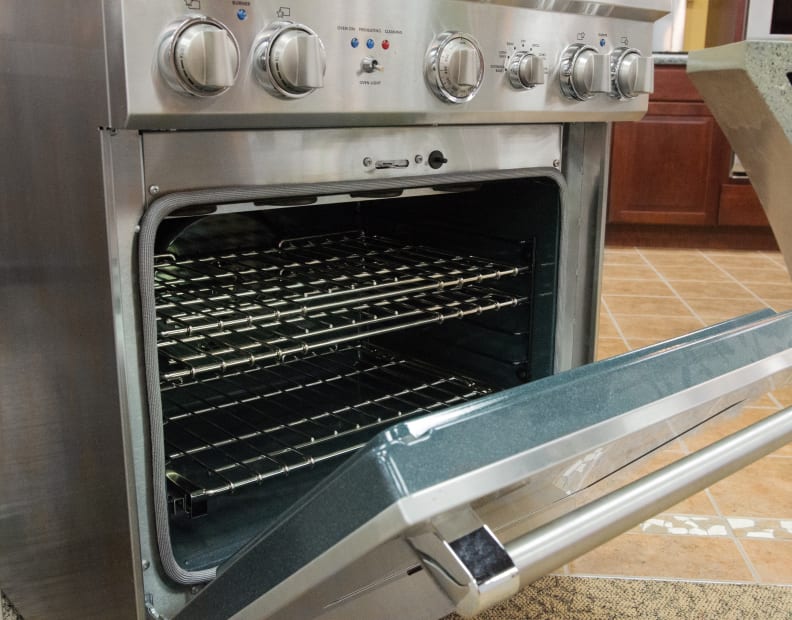
The oven cavity has a capacity of 4.4 cubic feet.
Our photospectrometer test is where the roast lost most of its points, due to a significant variation in browning between the sides and center of the pork loin. Convection Bake did improve the evenness of the browning a bit, and cooked through more quickly, taking just 33:24 min/lb. The roast lost more moisture when cooked at this setting, but still scored well, losing only 0.74 lbs of water. All things considered, convection did improve the quality of the results, and is likely to be the most effective setting to use when roasting meat.
As far as preheating went, the PRD304GHU’s oven proved quite speedy. With the regular bake setting, it took 11:21 for the cavity to reach the target 350°F, while convection took just 7:57. When we switched on the broiler, it took just over 6 minutes for the area below the broiler to reach a scorching 610°F—not bad at all.
Meet the tester
Kori began her journalism career as a teenage fashion blogger and has enjoyed covering a wide variety of topics ever since. In her spare time, she’s an amateur poet, avid reader, and gluten-free cake baker extraordinaire.
Checking our work.
Our team is here for one purpose: to help you buy the best stuff and love what you own. Our writers, editors, and lab technicians obsess over the products we cover to make sure you're confident and satisfied. Have a different opinion about something we recommend? Email us and we'll compare notes.
Shoot us an email
